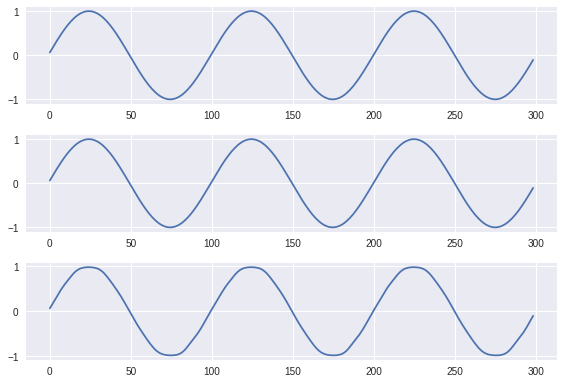概要
raspberry pi 1でtensorflow liteやってみた。
マイク入力を扱うので、alsaを叩いてみた。
そのまま、出力するモデルを学習してみた。
データセットの作成。
import numpy as np
sample_rate = 44100.
nsamples = 320
t = np.arange(nsamples) / sample_rate
vin = np.sin(2 * np.pi * 440. * t)
vsa = np.zeros((nsamples, 2))
a = 0
for i in range(nsamples):
vsa[i, 0] = vin[i]
vsa[i, 1] = vin[i]
data = np.c_[vsa[ : , 0], vsa[ : , 1], vin]
np.savetxt('sin.csv', data, delimiter = ',', header = "x0,x1,y")
print ("ok")
モデルを学習してtfliteファイルを作る。
import numpy as np
import tensorflow as tf
import tensorflow.contrib.lite as lite
import matplotlib.pyplot as plt
data = np.loadtxt('sin.csv', delimiter = ',', unpack = True)
x = np.c_[data[0], data[1]]
y = data[2]
fig = plt.figure(1)
ax = fig.add_subplot(311)
ax.plot(data[0][1 : 300])
ax = fig.add_subplot(312)
ax.plot(y[1 : 300])
ax = fig.add_subplot(313)
x_in = tf.placeholder("float", [None, 2])
y_out = tf.placeholder("float", [None, 1])
w1 = tf.Variable(tf.random_uniform([2, 8]))
b1 = tf.Variable(tf.zeros([8]))
y1 = tf.nn.tanh(tf.matmul(x_in, w1) + b1)
w2 = tf.Variable(tf.random_uniform([8, 1]))
b2 = tf.Variable(tf.zeros([1]))
y2 = tf.nn.tanh(tf.matmul(y1, w2) + b2)
loss = tf.nn.l2_loss(y2 - y_out)
train = tf.train.AdamOptimizer(0.001).minimize(loss)
with tf.Session() as sess:
sess.run(tf.initialize_all_variables())
for i in range(10001):
sess.run(train, feed_dict = {
x_in: x,
y_out: y.reshape(320, 1)
})
if i % 1000 == 0:
summary = sess.run(loss, feed_dict = {
x_in: x,
y_out: vin.reshape(320, 1)
})
print (i, summary)
test_y = sess.run(y2, feed_dict = {
x_in: x
})
converter = lite.TFLiteConverter.from_session(sess, [x_in], [y2])
tflite_model = converter.convert()
open("voice1.tflite", "wb").write(tflite_model)
ax.plot(test_y[1 : 300])
fig.set_tight_layout(True)
plt.show()
tfliteファイルを検証する。
import numpy as np
import tensorflow as tf
import tensorflow.contrib.lite as lite
import matplotlib.pyplot as plt
data = np.loadtxt('sin.csv', delimiter = ',', unpack = True)
x = np.c_[data[0], data[1]]
y = data[2]
fig = plt.figure(1)
ax = fig.add_subplot(311)
ax.plot(data[0][1 : 300])
ax = fig.add_subplot(312)
ax.plot(y[1 : 300])
ax = fig.add_subplot(313)
interpreter = lite.Interpreter(model_path = "voice1.tflite")
interpreter.allocate_tensors()
input_details = interpreter.get_input_details()
output_details = interpreter.get_output_details()
input_shape = input_details[0]['shape']
pred = []
for i in x:
input_data = np.array([i], dtype = np.float32)
interpreter.set_tensor(input_details[0]['index'], input_data)
interpreter.invoke()
output_data = interpreter.get_tensor(output_details[0]['index'])
pred.append(output_data[0][0])
ax.plot(pred[1 : 300])
fig.set_tight_layout(True)
plt.show()
以上。
